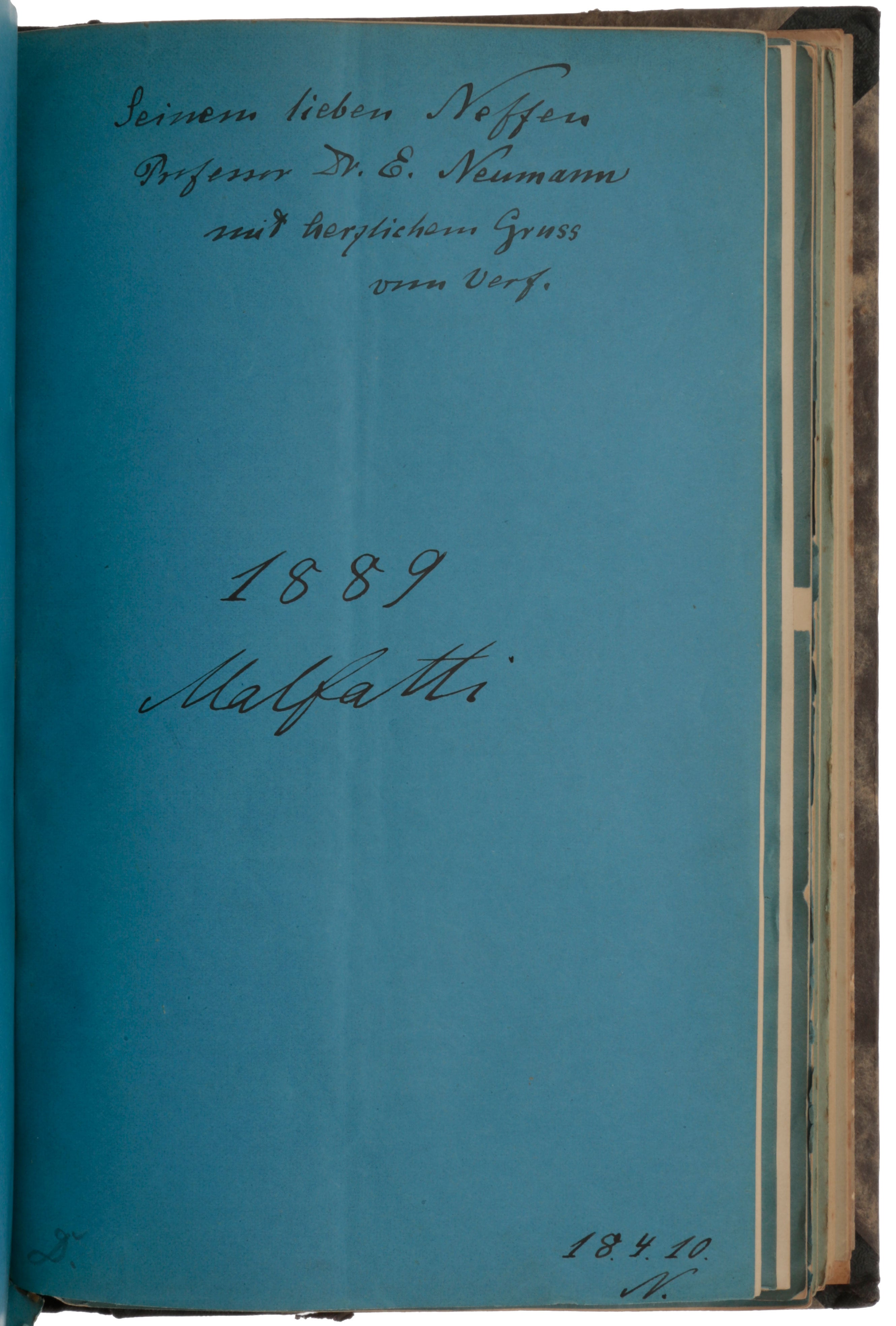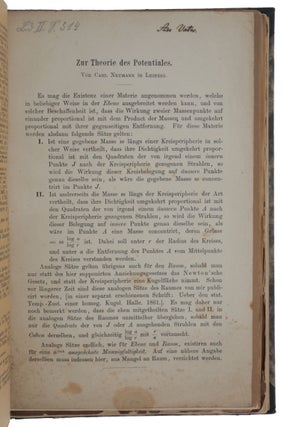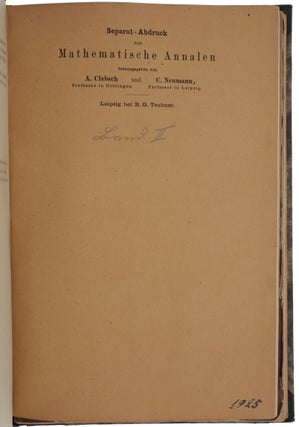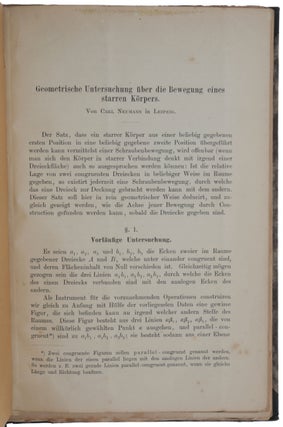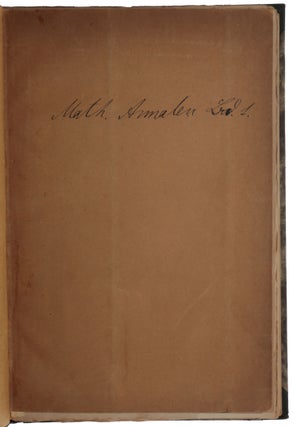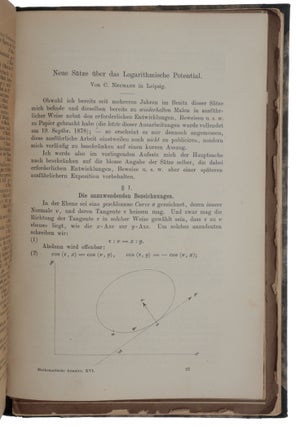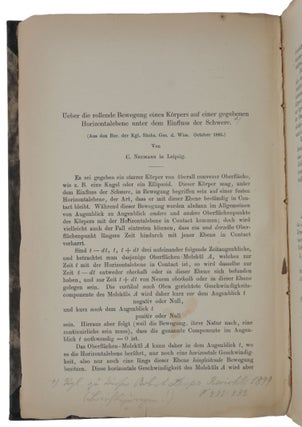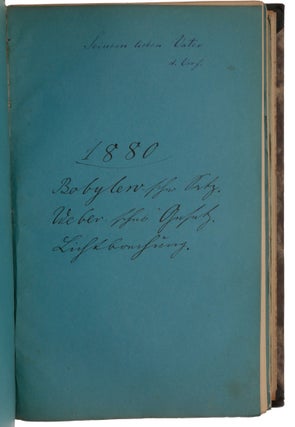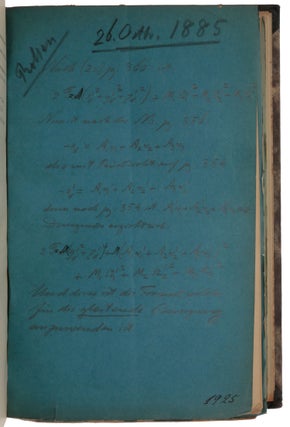Bound collection of some 140 offprints, of which 28 are inscribed and several have annotations in the text, documenting Neumann’s contributions to electromagnetism and potential theory, the subjects for which he is best known today.
Leipzig & Berlin: Gesellschaft der Wissenschaften zu Leipzig & Springer, 1869-1921. A remarkable collection of offprints, a major portion of the published works of Carl Gottfried Neumann (1832-1925), representing virtually all of the areas to which he contributed, most importantly the related fields of electromagnetism and potential theory. His lasting influence in these areas is reflected in the number of mathematical concepts which are today named after him, including the ‘Neumann-Poincaré operator,’ the ‘Neumann boundary value problem,’ the ‘Neumann boundary condition,’ the ‘Neumann series,’ and the ‘Neumann problem.’ “Stimulated by Bernhard Riemann’s work on electrodynamics, Neumann developed a theory founded on the finite [speed of] propagation of electrodynamic actions, which interested Wilhelm Eduard Weber and Rudolf Clausius into striking up a correspondence with him … Maxwell makes reference to the electrodynamic theory developed by Weber and Neumann in the Introduction to ‘A Dynamical Theory of the Electromagnetic Field’ (1864)” (Wikipedia). “As a researcher [Neumann] was especially prominent in the field of potential theory. His investigations into boundary value problems resulted in pioneering achievements; in 1870 he began to develop the method of the arithmetical mean for their solution. He also coined the term ‘logarithmic potential.’ The second boundary value problem of potential theory still bears his name; a generalization of it was later provided by H. Poincaré” (DSB). Much of Neumann’s work in potential theory was directed towards rehabilitating the ‘Dirichlet principle’ which had been used by Riemann in his epoch-making work on complex function theory and Riemann surfaces (1851), but whose validity was questioned following criticism by Karl Weierstrass. Neumann’s “method of the arithmetic mean, on the contrary, was appreciated as a correct method for obtaining the solution of the Dirichlet problem, although only on domains bounded by convex surfaces. Neumann’s method delivered not only an existence theorem but also the expansion of the solution in a series suitable for approximate calculation. It stimulated further research and progress in the theory of integral equations” (Kral & Netuka), and this in turn led to the birth of functional analysis. Indeed, “Neumann’s work can be understood as a catalyst for the creation of twentieth-century analysis” (Netuka). This is very much the Neumann-family collection of offprints: many of them are inscribed either to Neumann’s father, Franz Ernst Neumann (1798-1895), the mathematician and physicist who developed the first mathematical theory of electromagnetic induction, or to his nephew Ernst Richard Julius Neumann (1875-1955), a mathematician who continued his uncle’s work in potential theory. About a quarter of the papers in the collection were published in Mathematische Annalen, a journal which Carl Neumann founded and, during its first decade, edited, together with his friend Rudolf Clebsch, and which is still very much active today. “Neumann’s father, Franz Ernst Neumann, was professor of physics and mineralogy at Königsberg; his mother, Luise Florentine Hagen, was a sister-in-law of the astronomer F. W. Bessel. Neumann received his primary and secondary education in Königsberg, attended the university, and formed particularly close friendships with the analyst F. J. Richelot and the geometer L. O. Hesse. After passing the examination for secondary school teaching he obtained his doctorate in 1855; in 1858 he qualified for lecturing in mathematics at Halle, where he became Privatdozent and, in 1863, assistant professor. In the latter year he was called to Basel, and in 1865 to Tübingen. From the autumn of 1868 until his retirement in 1911 he was at the University of Leipzig. In 1864 he married Hermine Mathilde Elise Kloss; she died in 1875” (DSB). Neumann’s most important work was in potential theory. The concept of ‘potential’ arose first in the study of gravitational attraction: the potential (energy) is a function whose ‘gradient’, or rate of change, gives the gravitational force. “Lagrange introduced the idea of a potential function in 1773. His question was: how to determine the potential function of a given body, and thus its gravitational attraction? After Legendre had opened up the subject, Laplace showed how to find the potential function, V, for the gravitational force due to an arbitrary spheroid in 1782 by showing that it satisfied [the differential equation ΔV = Vxx + Vyy + Vzz = 0, where Vxx denotes the second partial derivative d2V/dx2, etc.], which is why we speak of Laplace’s equation today. In the 1780s Charles Coulomb, a French military engineer, proposed the inverse-square law in electrostatics, which differs from the law of gravitation only because the force [can be] one of repulsion … In his efforts to produce a mathematical theory of electrostatics, in 1813 Poisson was led to generalise Laplace’s equation to ΔV = – 4πρ” (Gray, p. 132), where ρ is the mass or charge density. In the 1820s, Poisson’s equation was shown to apply also to problems in electromagnetism by André-Marie Ampère. This connection between potential theory and electrodynamics in manifested in Neumann’s work, and in many of the articles collected in these volumes. In most questions in mathematical physics the Laplace-Poisson equation must be solved in some region of the plane or space with prescribed values on the boundary of the region (‘first boundary value problem’ or ‘Dirichlet problem’) or with prescribed values of the derivative in the direction perpendicular to the boundary (‘second boundary value problem’, now known as the ‘Neumann problem’). In his lectures at Göttingen in the 1840s, Gustav Lejeune Dirichlet showed that solving the Dirichlet problem is equivalent to finding a function that minimises a certain integral – this is the ‘Dirichlet principle’, so named by Riemann. Following Weierstrass’s critique of the principle in 1869, “the efforts to rehabilitate Riemann’s proof were many. The first to succeed, beginning around 1870, were those of Carl Neumann, known as the method of the arithmetic mean, which established the existence of solutions for the Dirichlet problem by a method of approximate solutions” (Archbald, p. 69). “In 1870 [Neumann] addressed the challenge to Riemann’s methods posed by Weierstrass by introducing a general technique for establishing the existence of solutions under specific circumstances. Neumann’s solution was constructive, but depended on special hypotheses about the region, most notably the convexity of the contours or surfaces bounding the [region]” (ibid, pp. 73-74). “At the meeting of April 21, 1870 of the Royal Saxon Society of Sciences in Leipzig, Neumann presented his first communication on general potential theory [1870a]. Neumann explained that he intended to present a series of communications on problems related to potential theory: conformal mapping, steady-state heat conduction, electrostatic and ‘electrokinetic’ equilibrium. The core of these papers, said Neumann, was a collection of general methods, independent of choice of coordinate system, intended to replace the Dirichlet principle in such arguments, which he now saw as ‘rightly held to be doubtful’ (mit Recht fur bedenklich erklarten) [1870a, p. 49]. He nevertheless remained attached to the Dirichlet principle, later describing it as ‘so beautiful and once so much employed, but now probably forever sunk’. These papers would appear over the next two decades, many recalling Neumann’s title here: ‘On the theory of the logarithmic and the Newtonian potential’” (ibid., pp. 74-75). In the second part of his paper with this title [1870b], Neumann gave a detailed account of his method of the arithmetic mean. Neumann continued to work on his method of the arithmetic mean, finally summarising his work in [1901b]. Many of Neumann’s works on potential theory refer to both the ‘logarithmic potential’ and the ‘Newtonian potential’. The latter refers to boundary-value problems in three-dimensional space, in which the gravitational force due to a point mass varies with the distance r from the point according to Newton’s inverse square law 1/r2 (and similarly for electrodynamics); the potential is then proportional to 1/r (since the derivative of 1/r is, apart from a sign, equal to 1/r2). The former, on the other hand, is relevant to problems in the plane, in which case the force is proportional to 1/r and the potential to log r. The difference bwteen the two cases is a reflection of the fact that the surface area of a sphere of radius r is proportional to r2, whereas the circumference of a circle of the same radius is proportional to r. “The theory of logarithmic and Newtonian potential was one of Neumann’s most important achievements. It contained not only the solution of the first but also of the second boundary value problem and created a solid base for the treatment of many physical questions by means of potential theory. Therefore it was an important contribution to the building of mathematical physics. The existence of a potential function had been proven up till then by physical arguments only, not mathematically … his method of arithmetical means was a very important step forward in the analysis of the 1870s and 80s. Neumann also derived interesting new results about the development of a periodic function into a Fourier series and about the convergence of such series [1881a, 1883a, 1913b]” (Schlote, pp. 131-132). In the 1890s Henri Poincaré extended the method of the arithmetic mean by proving the convergence of Neumann’s series for a large class of regions with non-convex boundaries. “In his research and in his teaching, Neumann related the theoretical needs of electricity and magnetism to potential theory, the part of mathematics in which he did his most important work” (Jungnickel & McCormmach, p. 182).“Neumann began his intensive researches on electrodynamics in the 1860s. The main problems at that time were to describe quantitatively the new phenomena that had been discovered, to improve the methods of their measurement, and to seek a general theoretical explanation of them that would encompass both contact and spatially-separated effects. One approach was to adopt the field concept that Faraday had proposed and Maxwell had formulated mathematically. Another competing approach was to assume action-at-a-distance forces. By adopting the latter approach, Franz Ernst Neumann had deduced the electrodynamic potential for the interaction of two linear currnts in 1845, from which he also derived the electrodynamic force that two closed circuits exert on aech other. Wilhelm Eduard Weber (1804-1901), also in 1845, had proposed his fundamental law describing the electrodynamic force acting between two current elements … A peculiarity of Weber’s law consisted in the assumption that the basic (or elementary) forces which were used for explaining electrodynamic phenomena depend not only on the mutual distance of the two current elements but also of the relative velocity and acceleration of their constituent charges. A further problem involved the explanation of electrical conduction … Weber developed a dualistic approach [which] assumed the existence of two electrical fluids of opposite charge whose equal and opposite flow in a conductor constituted the electrical current. In addition, there existed a unitary approach which that assumed the existence of a single, positively-charged electrical fluid with the negative charges being inseparably bound to ponderable particles in matter. When C. Neumann turned to investigations in electrodynamics he followed Weber’s dualistic approach and was familiar with the ideas and concepts of continental electrodynamics mostly originated in Germany” (Schlote, pp. 125-126). “In [1881b], he presented a new and complete electrodynamic theory making full use of the potential. He introduced the theory with the observation that the parts of physics fell into two classes corresponding to the basic forces used to explain their phenomena: those parts of physics whose forces are determined by the relative positions of particles, which include the gravitational, elastic, and capillary forces, and those parts whose forces depend on conditions such as velocity and acceleration in addition to relative positions. Unlike the forces of the first class, those of the second class, which included frictional, magnetic, perhaps optical, and above all electrodynamic forces, do not necessarily obey the law of the conservation of ‘living force’. Since the law relates kinetic and potential energy, and since for the second class of forces the potential energy is unknown, the problem of electrodynamic theory, Neumann concluded, is to determine the potential energy. “Neumann came to his new ‘principles’ of electrodynamics by studying Weber’s law of electrical action and finding a potential for it, which he regarded as more fundamental than the force itself. Riemann’s electrodynamic theory, published in 1867, showed Neumann how the electrodynamic force, a force of the second class, could be derived from the potential of the electrostatic force, a force of the first class, by assuming that the potential is propagated with finite velocity. To his surprise, he found that the usual electrostatic, or Newtonian, potential together with Riemann’s progressive propagation leads to the expression for the potential he had already discovered for Weber’s law. Neumann regarded as the major innovation of his theory, as it was of Riemann’s, the progressive nature of the moving electrical impulse, as determined by the potential [1881b, p. 402]. “Neumann put these several ideas together: by assuming that the potential between a pair of electrical points in relative motion propagates with the constsnt velocity c and that the emitted potential has the Newtonian form mm1/r, he derived the ‘effective’ received potential for Weber’s law … Declaring that Hamilton’s variation principle is ‘unconditionally valid’, and extending its application from dynamics to electrodynamics and from potentials of forces of the first class to potentials of forces of the second, Neumann derived from the variation of the action integral the known laws of electric attraction and induction and, at the same time, a form of the principle of the conservation of living force that embraces electrodynamics [1881b, pp. 405, 420]” (Jungnickel & McCormmach, pp. 182-183). “Neumann belived in a harmony between the intellect and the external world, which made mathematics, astronomy, physics, mineralogy, and chemistry appear to him as parts of a ‘single great whole.’ To his regret these sciences had increasingly grown apart in the course of the nineteenth century [1899a, p. lxiv]; Jacobi, Dirichlet, and Riemann had worked equally in mathematics and physics, but after them, Neumann believed, one came to expect mathematics only from mathematicians and physics only from physicists. The result was the impoverishment of both” (ibid., pp. 184-185). Archibald, ‘From attraction theory to existence proofs: the evolution of potential-theoretic methods in the study of boundary-value problems, 1860-1890,’ Revue de l’Histoire de Mathématiques 2 (1996), pp. 67-93. Gray, The Real and the Complex: A History of Analysis in the 19th Century, 2015. Jungnickel & McCormmach, Intellectual Mastery of Nature. Theoretical Physics from Ohm to Einstein, Vol. 1, 1986. Kral & Netuka, ‘Contractivity of C. Neumann’s operator in potential theory,’ Journal of Mathematical Analysis and its Applications 61 (1977), pp. 607-619. Netuka, ‘Lebesgue’s criticism of Carl Neumann’s method in potential theory,’ Archive for History of Exact Sciences (2019), pp. 1-32. Schlote, ‘Carl Neumann’s contributions to potential theory and electrodynamics,’ pp. 123-140 in European Mathematics in the Last Centuries (Wieslaw, ed.), 2005. CONTENTS BV = Berichte über die Verhandlungen der Königlich-Sächsischen Gesellschaft der Wissenschaften zu Leipzig MA = Mathematische Annalen ZMP = Zeitschrift für Mathematik und Physik (1866) Ueber Hamilton’s partielle Differentialgleichung mit besonderer Rücksicht auf die Probleme der relative Bewegung, ZMP 11 (1866), pp. [265], 266-279, [1, blank]. [MPF.1a] [With:] (1867a) Kurzer Abriss einer Theorie der Kugelfunctionen und Ultrakugelfunctionen, ZMP 12 (1867), pp. [97], 98-122. Original plain wrappers with manuscript title on front wrapper. [MPF.1b] (1867a) Another copy. Original plain wrappers with manuscript title on front wrapper. [MPF.14] (1867b) Ueber den Krümmungs-Schwerpunkt algebraischer Curven, ZMP 12 (1867), pp. [172], 173. [MPF.25a] [With:] (1867c) Ueber den Krümmungs-Schwerpunkt algebraischer Curven, ZMP 12 (1867), [425], 426-428. Original plain wrappers with manuscript title on front wrapper. [MPF.25b] (1869a) Untersuchungen über die Bewegung eines System starrer Körper, BV 21 (1869), pp. [1], [132], 133-137, [1, blank]. Original plain front wrapper with manuscript title. [BI.1] (1869a) Another copy. Original plain wrappers with manuscript title on front wrapper. [MPF.4] (1869b) Ueber die mechanische Energie der Schwefelsäure, BV 21 (1869), pp. [2], [213], 214-220. [BI.2a] [With:] (1869c) Ueber die Entwicklung einer Function nach Quadraten und Producten der Fourier-Bessel’schen Functionen, BV 21 (1869), pp. [221], 222-256. [BI.2b] [With:] (1869d) Ueber die Satz der virtuellen Verückungen, BV 21 (1869), pp. [257], 258-280 (pencil annotation to p. 257). Self-wrappers. [BI.2c] (1869d) Another copy. Original plain wrappers with manuscript title on front wrapper. [MPF.2] (1869e) Uber eine Erweiterung desjenigen Satzes der Integral-Rechnung, welcher der Theorie der Partialbruchzerlegung zu Grunde liegt, Nachrichten der Königlichen Gesellschaft der Wissenschaften zu Göttingen, No. 1, January 6, 1869, pp. 9-13 (contained in one complete journal issue, pp. 1-16). Original plain wrappers with manuscript title on front wrapper (offsetting onto adjacent wrappers). [MPF.22] (1869f) Geometrische Untersuchung über die Bewegung eines starren Körpers, MA 1 (1869), pp. [195], 196-207, [1, blank]. Self-wrappers. [A.1] (1869g) Zur Theorie der Functionaldeterminanten, MA 1 (1869), pp. [208-209]. Self-wrappers. [A.2] (1869h) Notizen zu einer kürzlich erschienenen Schrift über die Principien der Elektrodynamik, MA 1 (1869), pp. [317], 318-324. Self-wrappers. [A.3] (1869i) Ueber die Aetherbewegung in Krystallen, MA 1 (1869), pp. [325], 326-358. Self-wrappers. [A.4] (1869j) Notiz über das cykloidische Pendel, MA 1 (1869), pp. [507], 508. Self-wrappers. [A.5] (1869k) Ueber die Entwicklung einer Function nach Quadraten und Producten der Fourier-Bessel'schen Functionen, MA 3 (1869), pp. [581], 582-610. Original printed wrappers. [MPF.15] (1870a) Zur Theorie des Logarithmischen und des Newton’schen Potentiales. Erste Mitteilung, BV 22 (1870), pp. [49], 50-56. Self-wrappers. [BI.3] (1870b) Zur Theorie des Logarithmischen und des Newton’schen Potentiales. Zweite Mitteilung, BV 22 (1870), pp. [1], [264], 265-321, [1, blank]. Self-wrappers. [BI.4] (1870b) Another copy. Original plain wrappers with manuscript title on front wrapper. [MPF.10] (1870c) Ueber die Aertherbewegung in Krystallen (Nachtrag zu dem Aufsatz Bd. I. Pag. 325), MA 2 (1870), pp. [1, blank], [182], 183-186. [A.6a] [With:] (1870d) Ueber Producte und Quadrate der Bessel’schen Functionen, MA 2 (1870), p. [192], [1, blank]. Original printed wrappers. [A.6b] (1870e) Zur Theorie des Potentiales. MA 2 (1870), p. [514], [1, blank]. Self-wrappers. Inscribed ‘An Vater’. [A.7] (1871a)Elektrodynamische Untersuchungen mit besonderer Rücksicht auf das Princip der Energie, BV 23 (1871), pp. [1], [386], 387-449. [BI.5a] [With:] (1871b) Ueber die von Helmholtz in die Theorie der elektrischen Vorgänge eingeführten Prämissen, mit besonderer Rücksicht auf das Princip der Energie, BV 23 (1871), pp. [450], 451-478. Original plain front wrapper with manuscript title. [BI.5b] (1871c) Revision einiger allgemeiner Sätze aus der Theorie des Logarithmischen Potentials, MA 3 (1871), pp. [325], 326-354. [MPF.6a] [With:] (1871d) Revision einiger allgemeiner Sätze aus der Theorie des Newton’schen Potentiales. MA 3 (1871), pp. [424]. 425-434. Original plain wrappers with manuscript title on front wrapper. [MPF.6b] (1871c,d) Another copy. Original printed front wrapper. [A.8] (1871e) Ueber die Entwicklung einer Function nach Quadraten und Producten der Fourier-Bessel'schen Functionen, MA 3 (1871), pp. [581], 582-610. Original printed front wrapper. [A.9] (1871f) Notiz über die elliptischen und hyperelliptischen Integrale, MA 3 (1871), pp. [611], 612-630. Original printed wrappers (front wrapper chipped at fore-edge). [MPF.23] (1871f) Another copy. Self-wrappers. [A.10] (1872a)Ueber das Elementargesetz derjenigen elektromotrischen Kräft, welche in einem gegebenen Conductor hervotgebracht werden durch elektrische Ströme, sei es dass diese Ströme in demselben Conductor, sei es das sie in irgend einem andern gegen jenen sich bewegenden Conductor stattfinden. BV 24 (1872), pp. [2], [3], 4-23, [1, blank] (pencil corrections to pp. 10, 11, 16, 20, & 22). Self-wrappers. [BI.7] (1872b) Vorlaüfige Conjectur über die Umfahren der thermoelektrischen Ströme, BV 24 (1872), pp. [49], 50-64. Original plain front wrapper with manuscript title. [BI.6] (1872c) Ueber die Elementargesetze der Kräfte elektrodynamischen Ursprungs, MA 5 (1872), pp. [1, blank], [602], 603-624. Original printed front wrapper. [A.11] (1873a) Ueber die theoretische Behandlung der sogenannten constanten Magnete, MA 6 (1873), pp. [1, blank], [330], 331-341, [1, blank]. Original printed front wrapper. [A.12] (1873b) Ueber gewisse von Helmholtz für die Magnetoinduction und Voltainduction aufgestellte Formeln, MA 6 (1873), pp. [1, blank], [342], 343-349, [1, blank]. Original printed front wrapper. [A.13] (1873c) Notiz zu dem Aufsatz: Ueber die Elementargesetze der Kräfte elektrodynamischen Ursprungs (in Bd. 5, Seite 602), MA 6 (1873), pp. [350], [1, blank]. Self-wrappers. [A.14] (1874)Ueber die Helmholtz’sche Constante k, BV 26 (1874), pp. [1], [132], 133-152, [2, blank] (pencil and ink corrections to pp. 140, 142 & 146). Original plain front wrapper with manuscript title. [BI.8] (1875a) Das Weber’sche Gesetz in seiner Anwendung auf Gleitstellen, BV 27 (1875), pp. [1], 2-28. Original plain front wrapper with manuscript title. [BI.9] (1875b) Allgemeine Betrachtungen über das Weber’sche Gesetz, MA 8 (1875), pp. [555], 556-566 (pencil annotation to p. 555). Original printed front wrapper. [A.15] (1876a) Zwei Satze über correspondirende Flachen-elemente, BV 28 (1876), pp. [253], 254-267, [1, blank]. Original plain front wrapper. Inscribed ‘Seinem lieben Vater d. Verf.’ [BI.10] (1876b) Ueber den stationären elektrischen Strömungszustand in einer gekrümmten leitenden Fläche, MA 10 (1876), pp. [569], 570-571, [1, blank]. Self-wrappers. [A.16] (1877a) Ueber die peripolaren Coordinaten, BV 29 (1877), pp. [1], [134], 135-153, [1, blank]. Original plain wrappers with manuscript title on front wrapper. [BI.11] (1877a) Another copy (contained in a larger journal extract, pp. 133-153). Original plain wrappers with manuscript title on front wrapper. [MPF.18] (1877b) Zur Theorie der conformen Abbildung einer ebenen Fläche auf eine Kreisfläche, BV 29 (1877), pp. [1], 154-155. [BI.12a] [With:] (1878a) Neue Methode zur reduction gewisser Potentialaufgaben, BV 30 (1878), pp. [1], 2-9 (extensive pencil annotations to pp. 4-7). [BI.12b] [With:] (1878b) Ueber zwei von Green gegebene Formeln, BV 30 (1878), pp. 10-12. [BI.12c] [With:] (1878c) Ueber die Zusammensetzung der nach dem Weber’schen Gesetz sich ergebenen Beschleunigungen, BV 30 (1878), pp. 12-13. Original plain wrappers with manuscript title on front wrapper (geometrical diagram and calculations on inside rear wrapper). [BI.12d] (1877b, 1878a-c) Another copy. Original plain wrappers with manuscript title on front wrapper. [MPF.12] (1877c) Ueber correspondirende Flächenelemente, MA 11 (1877), pp. [1], 2-3, [1, blank]. Self-wrappers. [A.17] (1877d) Ueber die Zuverlässigkeit des Ampère’schen Gesetzes, MA 11 (1877), pp. [2], [309], 310-317. [A.18a] [With:] (1877e) Ueber die gegen das Weber’sche Gesetz erhobenen Einwände, MA 11 (1877), pp. [318], 319-340. Original printed front wrapper. [A.18b] (1877f) Die Zerlegung und Zusammensetzung der unendlich kleinen Bewegungen eines starren Körpers als Hülfsmittel bei Aufstellung der dynamischen Differentialgleichungen, MA 11 (1877), [379], 380-400 (pencil annotations in text and two pages of ms calculations inserted). Original printed wrappers (front wrapper chipped at fore-edge). [MPF.5] (1877f) Another copy. Original printed front wrapper. [A.19] (1877g) Zur Theorie des Logarithmischen und des Newton’schen Potentials, MA 11 (1877), pp. [1, blank], [558], 559-566. Original printed wrappers. [MPF.9] (1877g) Another copy. Original printed front wrapper. [A.20] (1877h) [Abstract of:] Untersuchungen uber das Logarithmische und Newton’sche Potential, Repertorium fur reine unde angewandte Mathematik (1877), pp. 108-151 (contained within a larger extract, pp. 97-162). Original plain wrappers with manuscript title on front wrapper. [MPF.7] (1878d) Entwicklung nach Elementarpotenzialen, BV 30 (1878), pp. [47], 48-90. Original plain wrappers with manuscript title on front wrapper. [MPF.11] (1878d)Another copy. Original plain front wrapper with manuscript title. [BI.13] (1878e) Untersuchungen über das Logarithmische und Newton’sche Potential. (Leipzig 1877.) Referat des Verfassers, MA 13 (1878), pp. [255], 256-300. Original printed wrappers (front wrapper chipped at fore-edge). [MPF.8] (1879e) Another copy. Original printed front wrapper. Inscribed ‘Seinem lieben Vater d. Verf.’ [A.21] (1878f) Ueber die Zusammensetzung der nach dem Weber’schen Gesetz sich ergebenden Beschleunigungen, MA 13 (1878), pp. [571], 572. Self-wrappers. [A.22] (1878g) Zur Theorie der conformen Abbildung einer ebenen Fläche auf eine Kreisfläche, MA 13 (1878), pp. [573], 574. Self-wrappers. [A.23] (1879)Ueber das Princip der virtuellen oder facultativen Verrückungen, BV 31 (1879), pp. [53], 54-64. Original plain wrappers with manuscript title on front wrapper. [BI.14] (1879) Another copy. Original plain wrappers with manuscript title on front wrapper. [MPF.3] (1880a) Verallgemeinerung des Bobylew’schen Satzes, BV 32 (1880), pp. [1], [22], 23-35. [BI.15a] [With:] (1880b) Ueber das Weber’sche Gesetz, BV 32 (1880), pp. 35-42. [BI.15b] [With:] (1880c) Ueber die Brechung eines unendlich dünnen regulären Strahlenbündels. BV 32 (1880), pp. 42-64. Original plain front wrapper with manuscript title. Inscribed ‘Seinem lieben Vater d. Verf.’ [BI.15c] (1880d) Neue Sätze über das Logarithmische Potential, MA 16 (1880), pp. [409], 410-431. [A.24a] [With:] (1880e) Neue Sätze über das Newton’sche Potential, MA 16 (1880), pp. [432], 433-438. Original printed front wrapper. [A.24b] (1880d) Another copy. Original printed wrappers. [MPF.13] (1881a) Ueber zwei von G. Kantor und P. du Bois-Reymond über die trigonometrischen reihen aufgestellte Sätze und deren uebertragung auf solche Reihen, die nach Kugelfunctionen fortschreiten, BV 33 (1881), pp. [1], 2-25, [1]. Original plain wrappers with manuscript title on front wrapper. [MPF.19] (1881a)Another copy. Original plain front wrapper with manuscript title. [BI.16] (1881b) Die Principien der Elektrodynamik, MA 17 (1881), pp. [1, blank], [400], 401-434. Original printed front wrapper. [A.25] (1881c) Ueber die Mehler’schen Kegelfunctionen und deren Anwendung auf elektrostatische Probleme, MA 18 (1881), pp. [195], 196-236 (ink annotation to p. 207). Original printed front wrapper. [A.26] (1881a-c) Another copy. Original printed wrappers. [MPF.17] (1881, F. G. MEHLER) Zur Theorie der Vertheilung der Elektricität in leitenden Körpern, MA 18 (1881), pp. [469], 470-506. Original printed wrappers. [MPF.16] (1883a) Ueber zwei von G. Kantor und P. du Bois-Reymond über die trigonometrischen reihen aufgestellte Sätze und deren uebertragung auf solche Reihen, die nach Kugelfunctionen fortschreiten. (Fortsetzung und Berichtigung …), BV 35 (1883), pp. [18], 19-34. Original plain wrappers with manuscript title on front wrapper. [MPF.20] (1883a) Another copy. Original plain front wrapper. [BI.17] (1883b)Ueber eine neue und einfache Methode zur Untersuchung der Stetigkeit, respective Unstetigkeit mehrdeutiger Functionen, BV 35 (1883), pp. [2], [85], 86-98. [MPF.24a] [With:] (1883c) Ueber das Verschwinden der Thetafunctionen, BV 35 (1883), pp. [99], 100–122. Original plain wrappers with manuscript title on front wrapper. [MPF.24b] (1883b,c) Another copy. Self-wrappers. [BI.18] (1883d) Ueber eine gewisse Erweiterung des Cantor’schen Satzes, MA 22 (1883), pp. [1, blank], [406], 407-415, [1, blank]. Original printed wrappers (chipped at fore-edge). [MPF.21] (1883d) Another copy. Original printed front wrapper. [A.27] (1885) Ueber die rollende Bewegung eines Körpers auf einer gegebenen Horizontal-Ebene unterdem Einfluss der Schwere. BV 37 (1885), pp. [1], [352], 353–378 (extensive pencil and ink annotations to pp. 352, 356, 359, 361 & 364). Original plain front wrapper (full-page mathematical annotations on recto). [BI.19] (1886a) Ausdehnung der Keppler’schen Gesetze auf den Fall, dass die Bewegung auf einer Kugelfläche stattfindet, BV 38 (1886), pp. [1], 2. Self-wrappers. [BI.20] (1886b) Ueber eine einfache Methode zur Begründung des Princips der virtuellen Verrückungen, BV 38 (1886), pp. [1], [70], 71–74 (ink annotation to p. 70). [BI.21a] [With:] (1886c) Ueber gewisse particulare Integrale der Differentialgleichung ΔF = F, insbesondere über die Entwickelung dieser particularen Integrale nach Kugelfunctionen, BV 38 (1886), pp. [75], 76-82 [2, blank] (pencil annotations to pp. 75, 78 & 82). Original plain front wrapper with manuscript title. Inscribed ‘Seinem lieben Vater d. Verf.’ [BI.21b] (1886d) Ueber die rollende Bewegung eines Körpers auf einer gegebenen Horizontalebene unter dem Einfluss der Schwere, MA 27 (1886), pp. [1, blank], [478], 479-501 (pencil annotations to pp. 478 & 489). [A.28a] [With:] (1886e) Ueber eine einfache Methode zur Begründung des Princips der virtuellen Verrückungen, MA 27 (1886), pp. [502], 503-505, [1, blank]. Original printed front wrapper. Inscribed ‘Seinem lieben Vater d. Vrf.’ [A.28b] (1887) Grundzüge der analytischen Mechanik, insbesondere der Mechanik starrer Körper. BV 39 (1887), pp. [153], 154-190 (pencil annotation to p. 176). Original plain front wrapper with manuscript title. Inscribed ‘Seinem lieben Vater d. Verf.’ [BI.22] (1888a) Grundzüge der analytischen Mechanik, insbesondere der Mechanik starrer Körper. Zweite Artikel, BV 40 (1888), pp. [22], 23-88 (pencil annotation to p. 42 with text on pp. 42 & 43 crossed through). Original plain front wrapper with manuscript title. Inscribed ‘Seinem lieben Vater d. Verf.’ [BI.23] (1888b) Ueber die Stetigkeit mehrdeutiger Functionen, BV 40 (1888), pp. [121], 122–124. Original plain wrappers. [BI.24] (1888c) Ueber das Verhalten der Green’schen Function an der Grenze ihres Gebietes, BV 40 (1888), pp. [163], 164-167, [3, blank]. Original plain wrappers. [BI.25] (1889) Ueber das Malfatti’sche Problem, BV 41 (1889), pp. [1], [22], 23-30. Original plain wrappers with manuscript title on front wrapper. Inscribed ‘Seinem lieben Neffen Professor Dr. E. Neumann mit herzlichen Gruss vom Verf.’ [BI.26] (1890a) Neue Sätze über das elektrostatische und über das magnetische Potential, BV 42 (1890), pp. [1], 88], 89-129, [1, blank]. Original plain front wrapper with manuscript title. Inscribed ‘Seinem lieben Vater d. Verf.’ [BI.27] (1890b) Ueber einige Fundamentalsätze der Potentialtheorie, BV 42 (1890), pp. [1], [326], 327-338, [2, blank]. Original plain front wrapper with manuscript title. [BI.28] (1891a) Bemerkungen zur mechanischen Theorie der Wärme, BV 43 (1891), pp. [75], 76-156. Original plain front wrapper with manuscript title. Inscribed ‘Meinem lieben und hochverehrten Vater.’ [BI.29] (1891b) Ein merkwürdiger Satz im Gebiete der Hydrodynamik, BV 43 (1891), pp. [567], 568-570. [BI.30a] [With:] (1891c) Ueber stationäre elektrische Flächenströme, BV 43 (1891), pp. [571], 572-574. Original plain wrappers with ‘C. N.’ on front wrapper. [BI.30b] (1892a) Analogien zwischen Hydrodynamik und Elektrodynamik, BV 44 (1892), pp. [1], [86], 87-105, [1, blank]. Original plain front wrapper. [BI.31] (1892b) Das Ostwald’sche Axiom des Energieumsatzes, BV 44 (1892), pp. [1], [184], 185-187, [1]. Self-wrappers. [BI.32] (1893) Zur Theorie des Magnetismus. Vorläufige Mittheilung, BV 45 (1893), pp. [429], 430-431, [1, blank] (pencil annotations to pp. 429 & 431). Original printed wrappers (pencil annotations to front wrapper). [BI.33] (1894a) Ueber die Bewegung der Wärme in compressiblen oder auch incompressiblen Flüssigkeiten, BV 46 (1894), pp. [1], 2-24. Original printed front wrapper. [BI.34] (1894b) Ueber das Newton’sche Gesetz, BV 46 (1894), pp. [279], 280-282. Original printed wrappers. [BI.35] (1895) Ueber einen Ersatz des Dirichlet’schen Princips für gewisse Fälle, BV 47 (1895), pp. [185], 186-200. Original printed front wrapper. [BI.36] (1896) Ueber die elektrodynamischen Elementarwirkungen, BV 48 (1896), pp. [221], 222-290, [2, blank]. Original printed front wrapper. [BI.37] (1897) Die Anwendung des Hamilton’schen Princips in der Hydrodynamik und Aërodynamik, BV 49 (1897), pp. [611], 612-615. Original printed wrappers. [BI.38] (1899a) Worte zum Gedächtniss an Wilhelm Hankel, gesprochen am 21. Februar 1899, BV 51 (1899), pp. [3], 4-7, [1, blank]. Original printed wrappers. [BI.39] (1899b) Beiträge zur analytischen Mechanik, BV 51 (1899), pp. [371], 372-444 (pencil annotation on p. 442). Original printed front wrapper. [BII.1] (1901a) Ueber eine neue Methode zum Beweise der sogenannten Schliessungstheoreme, BV 53 (1901), pp. [319], 320-332 (ink corrections to three words on p. 320). Original printed wrappers. [BII.2] (1901b) Ueber die Methode des arithmetischen Mittels, insbesondere über die Vervollkommnungen, welche die betreffenden Poincaré’schen Untersuchungen in letzter Zeit durch die Arbeiten von A. Korn und E. R. Neumann erhalten haben, MA 54 (1901), pp. [1], 2-48 (pencil annotation to p. 30). Original printed front wrapper. Inscribed ‘Herrn Dr. E. Neumann, mit bestem Gruss vom Verf.’ [A.29] (1902a) Über Metallreflexion und über totale Reflexion, BV 54 (1902), pp. [1, blank], [92], 93-100. Original printed wrappers. [BII.3] (1902b) Beiträge zur analytischen Mechanik. Zweite und dritte Abhandlung, BV 54 (1902), pp. [333], 334-362, [2, blank]. Original printed front wrapper. [BII.4] (1903) Über eine gewisse Gattung von Kugelflächen-Integralen, BV 55 (1903), pp. [1], [26], 265-–286. Original printed front wrapper. Inscribed ‘Seinem lieben Neffen E. Neumann mit herzlichem Gruss d. Verf.’ [BII.5] (1904a) Über Funktionen, die von drei reellen Argumenten abhängen, BV 56 (1904), pp. [5], 6-12. [BII.6a] [With:] (1904b) Über die Hervorbringung der Kettenlinie durch Biegung einer Kreisfläche, BV 56 (1904), pp. [13], 14-18. Original printed front wrapper. Inscribed ‘Seinem lieben Neffen mit bestem Gruss d. Verf.’ [BII.6b] (1906a) Über zwei inkongruente Polyeder, BV 58 (1906), pp. [471], 472-482. Original printed front wrapper. [BII.8] (1906b) Über das Logarithmische Potential, BV 58 (1906), pp. [483], 484-559 (pencil annotation to p. 507). Original printed front wrapper. Inscribed ‘Seinem lieben Neffen Prof. E. R. N. vom Verf.’ [BII.7] (1907) Über das logarithmische Potential einer gewissen Ovalfläche, BV 59 (1907), pp. [278], 279-312. Original printed front wrapper. Inscribed ‘Seinem lieben Neffen mit bestem Gruss d. Verf.’ [BII.9] (1908a) Über das logarithmische Potential einer gewissen Ovalfläche. Zweite Abhandlungen, BV60 (1908), pp. [53], 54-56. Original printed front wrapper. [BII.10] (1908b) Einige Äußerungen C. G. J. Jacobis über die Prinzipien der analytischen Mechanik, BV 60 (1908), pp. [80], 81-84. Original printed front wrapper. [BII.11] (1908c) Über das logarithmische Potential einer gewissen Ovalfläche. Dritte Abhandlungen, BV60 (1908), pp. [1], [240], 241-247. Original printed front wrapper. Inscribed ‘Seinem lieben Neffen Herrn Prof. E. Neuman d. Verf.’ [BII.12] (1908d) Über die Entwicklung der ganzen Potenzen der reziproken Entfernung zweier Punkte nachKugelfunktionen, BV 60 (1908), pp. [2], [269], 270-274. Original printed front wrapper. Inscribed ‘Seinem lieben Neffen mit bestem Gruss übersendet v. Verf.’ [BII.13] (1908e) Worte zum Gedächtnis an Wilhelm Scheibner. Nekrolog gesprochen in der öffentlichen Gesamtsitzung reider Klassen am 14. November 1908. BV 60 (1908), pp. [2], 377-390. Original printed front wrapper. Inscribed ‘Mit herzlichem Gruss von C. N.’ [BII.14] (1909) Zur Theorie des logarithmischen Potentials. Aufsatz I, BV 61 (1909), pp. [1], 156-170. Original printed front wrapper. Inscribed ‘Seinem lieben Neffen Herrn Prof. Dr. E. Neumann mit bestem Gruss v. Verf.’ [BII.15] (1910a) Über den Körper Alpha, BV 62 (1910), pp. [69], 70-86. Original printed front wrapper. Inscribed ‘Seinem lieben Neffen Prof. Dr. E. Neumann v. Verf.’ [BII.16] (1910b) Zur Theorie des logarithmischen Potentials. Aufsatz II, BV 62 (1910), pp. [87], 88-169, [1] (pencil annotations to pp. 125, 134, & 136). Original printed front wrapper. [BII.17] (1910c) Zur Theorie des logarithmischen Potentials. Aufsatz III, BV 62 (1910), pp. [1], [27], 279-290. Original printed front wrapper. [BII.18] (1910d) Zur Theorie des logarithmischen Potentials. Aufsatz IV, BV 62 (1910), pp. [2], 307-367 (manuscript notes and diagram inserted between pp. 314 & 315, pencil annotations to pp. 334, 340, & 368). [BII.19a] [With:] (1910e) Zur Theorie des logarithmischen Potentials. Aufsatz V, Erweiterung der Dürllschen Methode. BV 62 (1910), pp. 368-376. Original printed front wrapper. Inscribed ‘Herrn Professor Dr. E. R. Neumann mit bestem Gruss vom Verf.’ [BII.19b] (1910f) Nachtrag zu dem Aufsatz über den Körper Alpha, BV 62 (1910), pp. [2], 383-385, [1, blank] (pencil correction to p. 383). Original printed front wrapper. [BII.20] (1911a) Zur Theorie des logarithmischen Potentials. Aufsatz VI, BV 63 (1911), pp. [1], 226-239 (pencil annotations to pp. 229 & 232). [BII.21a] [With:] (1911b) Zur Theorie des logarithmischen Potentials. Aufsatz VII. Über das Riemannsche Abbildungsproblem, BV 63 (1911), pp. 240-248. Original printed front wrapper. [BII.21b] (1911c) Zur Theorie des logarithmischen Potentials. Aufsatz VIII. (Über die Fourierschen Reihen.), BV 63 (1911), pp. [407], 408-419, [1]. Original printed front wrapper. With a manuscript note on front wrapper signed ‘C. N.’ and dated December 1911 in which the author sates that he has found a stronger version of the results stated on pp. 414 & 417. [BII.22] (1912a) Zur Theorie des logarithmischen Potentials. Aufsatz IX. (Über die Fourierschen Reihen.), BV 64 (1912), pp. [2], 115-119 (pencil annotations to pp. 117 & 118). Original printed front wrapper. Inscribed ‘Seinem lieben Neffen E. Neumann d. Verf.’ [BII.23] (1912b) Einige elementare Sätze über periodische Funktionen, BV 64 (1912), pp. [1], 120-143, [1, blank]. Original printed front wrapper. Inscribed ‘Seinem lieben Neffen E. Neumann d. Verf.’ [BII.24] (1912c) Zur Theorie des logarithmischen Potentials. Aufsatz X. (Die Kreisbogenaufgabe.), BV 64 (1912), pp. [2], 273-339 (pencil annotation to p. 336). [BII.25a] [With:] (1912d) Zur Theorie des logarithmischen Potentials. Aufsatz XI. (Fortsetzung des Aufsatzes X.), BV 64 (1912), pp. 340-398. Original printed front wrapper. Inscribed ‘Seinem lieben Neffen E. R. N. mit bestem Gruss v. Verf.’ [BII.25b] (1913a) Zur Theorie des logarithmischen Potentials. Aufsatz XII. (Integraldarstellung vonFunktionen.), BV 65 (1913), pp. [1], 144-184. Original printed front wrapper. Inscribed ‘Seinem lieben Neffen Herrn Prof. Ernst Neumann in Marburg.’ [BII.26] (1913b) Zur Theorie der Fourierschen Reihen, BV 65 (1913), pp. [2], [197], 198. Original printed front wrapper. [BII.27] (1914) Das allgemeine Cauchysche Theorem … in seiner Anwendung auf die Kreisbogenaufgabe, BV 66 (1914), pp. [1], [160], 161-170 (pencil annotations to pp. 168-170). Original printed front wrapper. [BII.28] (1915) Zur Theorie der Äquipotentialität, BV 67 (1915), pp. [1], [188], 189-193, [1, blank]. Original printed front wrapper. [BII.29] (1916) Das allgemeine Cauchysche Theorem. Zur Vervollständigung der am 7. Dezember 1914 gemachten Mitteilung, BV 68 (1916), pp. [1], 8–10. Original printed front wrapper. [BII.30] (1917) Über die Integralformel der Randwertaufgaben, BV 69 (1917), pp. [1], [454], 455-456 (pencil annotation to p. 456). Original printed wrappers. Inscribed ‘Herrn Prof. Dr. E. Neumann in Marburg (Hessen) Schwernen (?) Allee. 9.’ [BII.31] (1919a) Über die von Franz Neumann gegebene Begründung des Hauyschen Gesetzes, BV 71 (1919), pp. [35], 36-80 (pencil annotations to pp. 71 & 72). Original printed front wrapper. Inscribed ‘Seinem lieben Neffen E. Neumann d V.’ [BII.32] (1919b) Über die von Franz Neumann im Jahre 1823 gegebene Projektionsmethode, BV 71 (1919), pp. [2], [313], 314-345. Original printed front wrapper. [BII.33] (1921) Eine Modifikation der von Dirichlet im Jahre 1829 gegebenen Theorie, BV 73 (1921), pp. [2], [201], 202-214. Original printed front wrapper. Inscribed ‘S. l. Neffen E. N. d. Vf.’ [BII.34]
Four vols., 8vo (224 x 140 mm). One vol. in nineteenth-century half-cloth and marbled boards with vellum tips and spine ends, spine lettered in gilt ‘M.P.F.’, former owner’s name stamp on front free endpaper; the other three vols. uniformly bound in early twentieth-century half-cloth and marbled boards, spines lettered in gilt ‘C. N. ANNALEN’, ‘C. N. Leipz. Berichte 1869-1892’, and ‘C. N. Leipz. Berichte 1899-1921’, former owner’s name stamp on front free endpaper of two vols. and on half-title of first article in the third vol.
Item #4934
Price: $4,500.00

